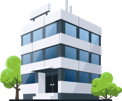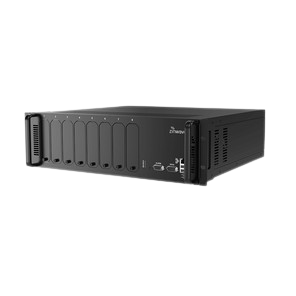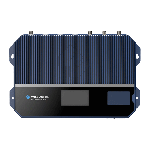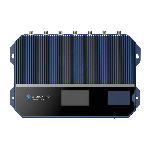Active DAS vs Passive DAS: What's the Difference
Which DAS is Best for Your Business? Active or Passive?
The majority of buildings are not built with cellular signal in mind. So, while decent cell reception may be available outside, it significantly decreases once inside. This is because building materials like metal and concrete weaken or block cellular signals.
Hospitals, schools, retail stores, and other entities often turn to Distributed Antenna Systems (DAS), usually Active DAS or Passive DAS, to improve in-building cellular coverage. Deciding which solution is best for your building can be challenging. To help you make an informed decision, we'll be covering the difference between Passive and Active DAS.
We fix poor cell phone signal! Find the right signal booster for you:




What is a DAS System?
A DAS, short for distributed antenna system, is an extensive network of strategically placed antennas throughout a building to enhance cellular coverage where it's needed. Applications include hospitals, hotels, multi-story commercial buildings, convention centers, stadiums, schools, and the like.
The DAS antennas are all linked to a central processing point, which receives cellular signals from a signal source. The signal source can be off-air cellular (via an antenna on the roof), an on-site Base Transceiver Station (BTS), or small cell.
Active DAS and Passive DAS are the two main in-building cellular signal boosting solutions.

How Active DAS Works
Active systems are the most powerful DAS option. They provide greater coverage and increase capacity.
These systems receive cellular signals directly from cellular carriers (AT&T, Verizon, or T-Mobile). In most cases, carrier approval is needed from every provider whose signal you are planning to enhance in your building.
Received cell signal is converted to digital for transmission over fiber optic cable or ethernet cable. Using these types of cables significantly decreases signal loss and allows for longer cable runs. The transmission of a stronger signal results in superior results.
Before the signal is broadcasted, it’s converted back to cellular.
How Passive DAS Works
Passive DAS systems, also known as cell phone signal boosters or bi-directional amplifiers (BDA), use a donor antenna (omni or uni-directional) to send and receive off-air cellular signals from nearby cell towers.
The signal picked up by the donor antenna is sent to a repeater for boosting. The indoor panel or dome antennas rebroadcast the boosted signal throughout. Coaxial cable is used for signal transmission. Because of signal loss, coaxial cable has length limitations.
The system's amplification power and coverage area are dictated by the quality and strength of your outside signal.
What's the Difference Between Active DAS and Passive DAS?
At first glance, an Active Distributed Antenna System seems like a no-brainer. Who wouldn't want the best possible coverage and capacity? However, it's not the best solution for all businesses. Here are the main differences between the two types of DAS:
1) Performance
Active DAS simulates having a cell tower in your building. It uses equipment that can handle and transmit a stronger signal, enabling superior coverage across a single building or campus. It also adds capacity, allowing more people to connect. Due to its capabilities, Active DAS is recommended for high-traffic buildings over 500,000 sq ft.
Passive DAS, on the other hand, improves in-building coverage. It does not add capacity. Results will vary depending on outside cellular signal strength. Buildings in the city with strong signal will get more coverage than those in rural areas with weak signal. Passive DAS is typically best for buildings ranging from 25,000 to 500,000 sq ft with multiple amplifiers.
2) Cost
An Active DAS can be up to 10 times more expensive compared to a cellular signal booster of equal coverage.
Whereas a cell signal booster simply takes the existing signal, amplifies it, and rebroadcasts the enhanced signal into the building, Active DAS requires more expensive components and dedicated monitoring systems to do the same job.
For example, most Active DAS systems use fiber optic cables to transmit signals from one component to the next. While a very good performer, custom cabling may be needed if building doesn't have existing infrastructure.
That is only one component of Active DAS. Other equipment - such as additional components to improve coverage for multiple carriers - adds to the cost, workload, and deployment time, resulting in higher installation service fees.
Most commercial signal boosters use the standard LMR 400 spec coax cables, which are much cheaper than fiber. Special equipment is not needed for deployment.
On average, an Active DAS costs between $5 to $10 per sq ft, while a Passive DAS costs between $0.50 to $1 per sq ft. To put this into perspective, with a 100,000 sq ft building, you can expect costs from $500,000 - $1,000,000 with an Active DAS, versus $50,000 - $100,000 with a commercial cell phone signal booster system.
3) Carrier Permissions
Cell signal boosters are FCC-certified and given immediate blanket consent for use with all major carriers such as AT&T, Verizon, T-Mobile, and many more. All you have to do is register the signal booster with your cellular provider. The process takes a few minutes.
Active DAS needs special equipment from the carrier to connect directly to their core network. Approvals are needed per desired carrier.
4) Installation Time
Installing an Active DAS can take several months to several years. This includes carrier permission, connecting equipment to carrier core networks, custom cabling, and installing antennas. The carrier approval process alone can take a minimum of 6 months per carrier. Without approval, the equipment can’t be installed.
To integrate an Active DAS that works with multiple carriers, multiple permissions are required, and additional equipment will be needed to communicate with each carrier’s core network. This makes Active DAS installations more complex, thus lengthening installation times even more.
A Passive DAS, on the other hand, can take a few weeks to install. Certified installers would first visit your building and conduct a site survey to understand your building’s unique design, current signal coverage, make equipment recommendations, and determine the best installation points. With that information, a custom-built system design plan can be deployed to maximize cellular coverage in your building. After the design has been completed, the equipment will be professionally installed.
5) Supported Cellular Carriers
Most cell phone signal boosters are designed to support multiple carriers at the same time. Depending on your signal situation, multiple external antennas may be needed.
Active DAS can also support multiple carriers. However, carrier-specific equipment is needed per carrier whose signal you want to improve in your building.
Best Active DAS Solution
Zinwave is the leader of Active DAS solutions. They have been leading the way in DAS for over 10 years. They offer the most innovative and cost-effective DAS system. It's wideband, fiber-based, and future-proof.
One single layer of hardware provides reliable in-building and on-campus 2G/3G/4G/5G cellular from any carrier as well as public safety, two-way radio, and other wireless services.

Best Passive DAS Solution
WilsonPro offers top-of-the-line cell phone signal boosters. They include a professional installation for optimal results.

Best for medium enterprises. Up to 40,000 sq ft coverage.
Contact Us For Pricing
Best for large enterprises. Up to 100,000 sq ft coverage.
Contact Us For PricingDo Cell Phone Signal Boosters Even Work?
Yes, signal boosters (aka Passive DAS) do indeed work. The only thing they require is usable outside signal, which isn’t usually a problem for commercial buildings.
Poor cellular service inside commercial buildings is usually caused by cell tower distance or building material.
With proper installation, signal boosters are designed to reach those far-distanced cell towers in remote locations and bypass any building material blocking the signal from entering the building.
The indoor antennas will broadcast boosted 5G (on select frequencies), 4G, and LTE signals throughout the facility. All users are guaranteed to experience superior cell service and faster data speeds.
You don’t have to take our word for it though. Check out our case studies to see how our signal boosters have helped other businesses.
Some of out Passive DAS customers include the Department of Defense, Microsoft, Nike, GE, Coca-Cola, Chevron, Valero, Halliburton, and Apple.
When is an Active DAS Better than a Signal Booster?
A single commercial cell phone signal booster can cover multi-story buildings up to 100,000 sq ft. For more coverage, multiple signal boosters can be combined. Signal booster systems should strongly be considered for buildings no larger than 500,000 sq ft.
On the other hand, very large venues over 500,000 sq ft, like stadiums, convention centers, and airports, require long cable runs. To achieve these lengthy cable runs, pricey equipment, and fiber in-place are needed rather than coaxial.
Signal boosters don’t do as well with long cable runs as Active Distributed Antenna Systems do. The boosted signal will slowly degrade as it travels through more coax cable, which is why multiple amplifiers are needed to minimize signal loss. Thus, an Active DAS is the best choice for extremely large high-traffic buildings and those where there is virtually no outside signal.
It’s recommended to consult a cell signal booster and DAS expert for thorough plans, pricing, and realistic outcomes.
How May We Help You?
Wilson Amplifiers is the leading provider of cell phone signal boosters. Cell phone boosters amplify 5G, 4G, and LTE for any phone with any carrier for home, office, or vehicle. They are 5G ready and will be able to be used until 2030 and beyond.
We seriously hate dropped phone calls and poor cell coverage, so it's our goal in life to stomp out spotty signal:
- Free consultation (ask us anything) with our US-based customer support ((sales@wilsonamplifiers.com) or call us at 1-800-568-2723.
- Free shipping.
- Better signal or industry-leading 90 money-back guaranteed. No questions asked.
- We want everyone to be satisfied, so we provide lifetime technical support and a 2-year warranty for all products.
Ask us anything and we'll be glad to help.
Interested in Learning More? Check Out Our Signal Boosting Info Center


Money Back Guarantee

Technical Support